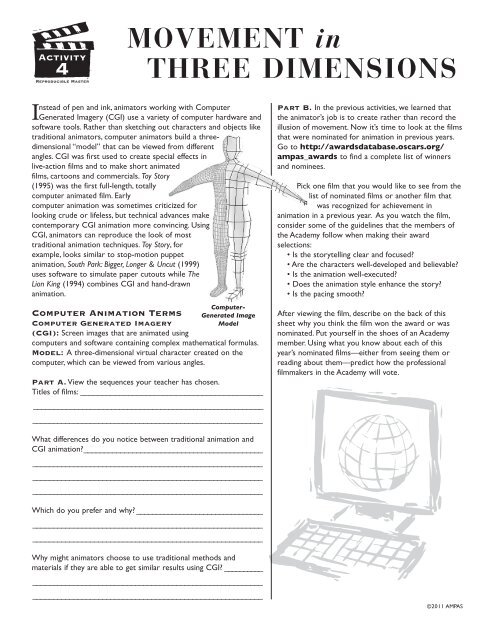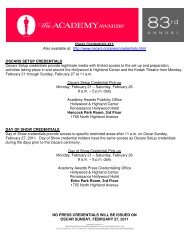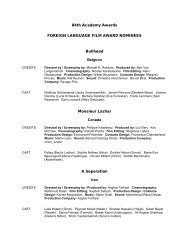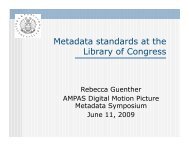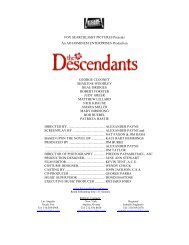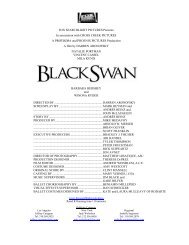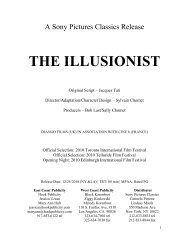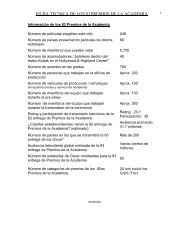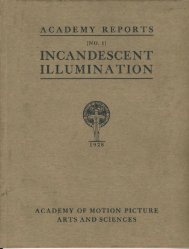CREATING MOVEMENT FRAME by FRAME - Academy of Motion ...
CREATING MOVEMENT FRAME by FRAME - Academy of Motion ...
CREATING MOVEMENT FRAME by FRAME - Academy of Motion ...
Create successful ePaper yourself
Turn your PDF publications into a flip-book with our unique Google optimized e-Paper software.
Activity<br />
4<br />
Reproducible Master<br />
<strong>MOVEMENT</strong> in<br />
THREE DIMENSIONS<br />
Instead <strong>of</strong> pen and ink, animators working with Computer<br />
Generated Imagery (CGI) use a variety <strong>of</strong> computer hardware and<br />
s<strong>of</strong>tware tools. Rather than sketching out characters and objects like<br />
traditional animators, computer animators build a threedimensional<br />
“model” that can be viewed from different<br />
angles. CGI was first used to create special effects in<br />
live-action films and to make short animated<br />
films, cartoons and commercials. Toy Story<br />
(1995) was the first full-length, totally<br />
computer animated film. Early<br />
computer animation was sometimes criticized for<br />
looking crude or lifeless, but technical advances make<br />
contemporary CGI animation more convincing. Using<br />
CGI, animators can reproduce the look <strong>of</strong> most<br />
traditional animation techniques. Toy Story, for<br />
example, looks similar to stop-motion puppet<br />
animation, South Park: Bigger, Longer & Uncut (1999)<br />
uses s<strong>of</strong>tware to simulate paper cutouts while The<br />
Lion King (1994) combines CGI and hand-drawn<br />
animation.<br />
Computer Animation Terms<br />
Computer Generated Imagery<br />
(CGI): Screen images that are animated using<br />
Computer-<br />
Generated Image<br />
Model<br />
computers and s<strong>of</strong>tware containing complex mathematical formulas.<br />
Model: A three-dimensional virtual character created on the<br />
computer, which can be viewed from various angles.<br />
Part A. View the sequences your teacher has chosen.<br />
Titles <strong>of</strong> films: __________________________________________<br />
________________________________________________________<br />
________________________________________________________<br />
What differences do you notice between traditional animation and<br />
CGI animation?____________________________________________<br />
________________________________________________________<br />
________________________________________________________<br />
________________________________________________________<br />
Which do you prefer and why? ________________________________<br />
________________________________________________________<br />
________________________________________________________<br />
Why might animators choose to use traditional methods and<br />
materials if they are able to get similar results using CGI? __________<br />
________________________________________________________<br />
________________________________________________________<br />
Part B. In the previous activities, we learned that<br />
the animator’s job is to create rather than record the<br />
illusion <strong>of</strong> movement. Now it’s time to look at the films<br />
that were nominated for animation in previous years.<br />
Go to http://awardsdatabase.oscars.org/<br />
ampas_awards to find a complete list <strong>of</strong> winners<br />
and nominees.<br />
Pick one film that you would like to see from the<br />
list <strong>of</strong> nominated films or another film that<br />
was recognized for achievement in<br />
animation in a previous year. As you watch the film,<br />
consider some <strong>of</strong> the guidelines that the members <strong>of</strong><br />
the <strong>Academy</strong> follow when making their award<br />
selections:<br />
• Is the storytelling clear and focused?<br />
• Are the characters well-developed and believable?<br />
• Is the animation well-executed?<br />
• Does the animation style enhance the story?<br />
• Is the pacing smooth?<br />
After viewing the film, describe on the back <strong>of</strong> this<br />
sheet why you think the film won the award or was<br />
nominated. Put yourself in the shoes <strong>of</strong> an <strong>Academy</strong><br />
member. Using what you know about each <strong>of</strong> this<br />
year’s nominated films—either from seeing them or<br />
reading about them—predict how the pr<strong>of</strong>essional<br />
filmmakers in the <strong>Academy</strong> will vote.<br />
©2011 AMPAS


